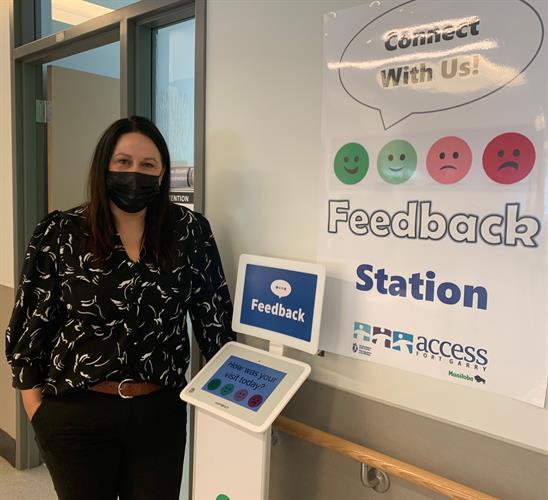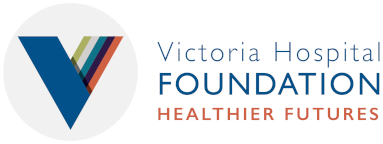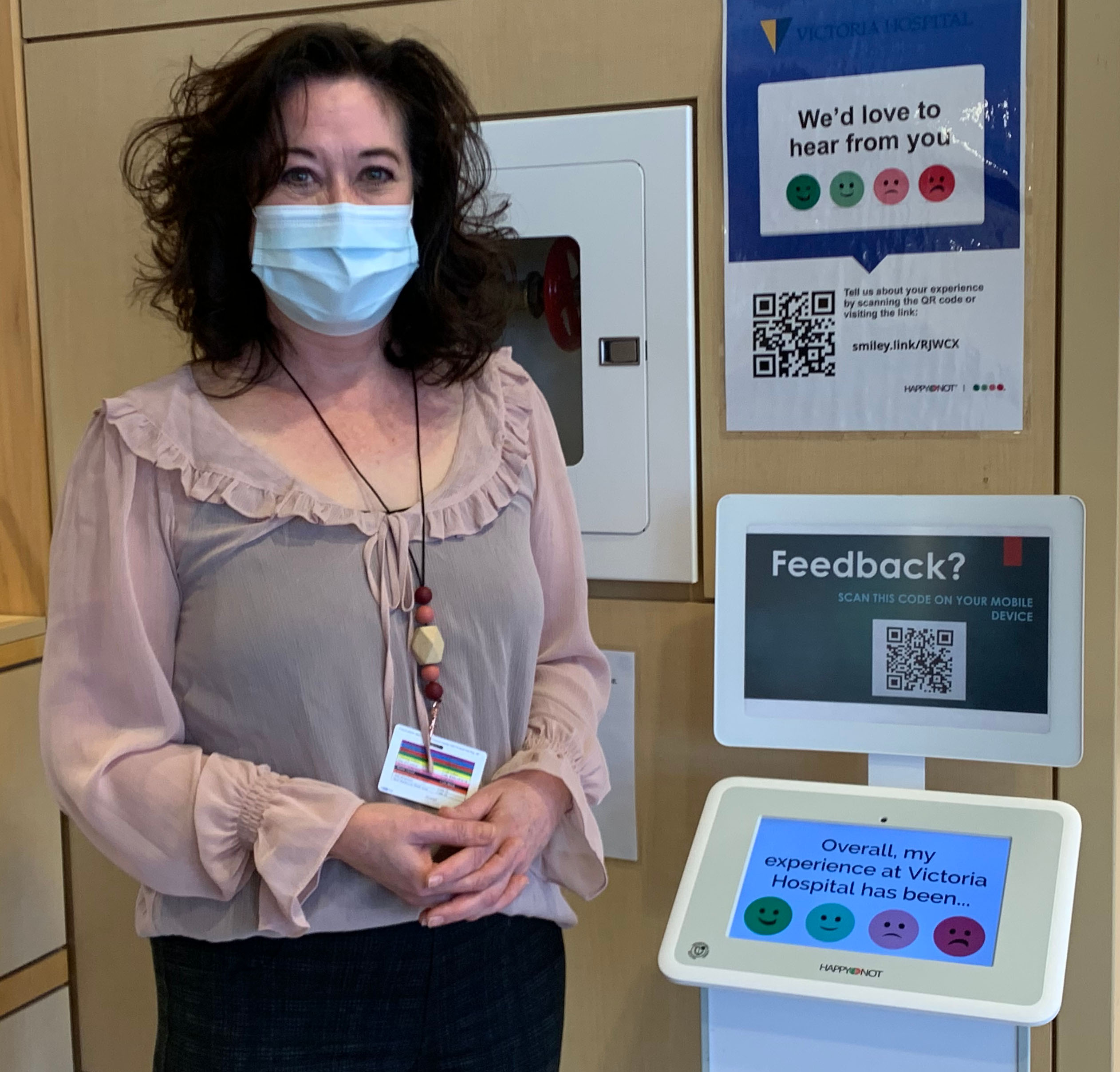Patients and families can easily share their thoughts and feelings at the touch of a button thanks to new real-time feedback kiosks at Victoria Hospital and ACCESS Fort Garry. Our investment in these innovative devices was made possible thanks to the generosity of our supporters.
After spotting a feedback kiosk at an airport, Victoria Hospital's Quality Improvement team was inspired to research new and improved ways for patients and families to quickly and easily share their experiences.
“People want to give feedback,” said Corine Poirier, Patient Relations Associate at Victoria Hospital. “But it’s hard to give feedback after a delay in time. And it’s difficult to give feedback when there aren’t quick ways of doing it. The quality of care that we can provide as a hospital relies on getting that feedback. Ultimately, it is patients and their families or natural supports who are going to drive the system and help the system to evolve. We can be better prepared as healthcare workers to support patients and families if we know what their concerns are.”
The team’s research led them to the HappyOrNot feedback devices, which were implemented in October. ACCESS Fort Garry became the first community site in Manitoba with one of these machines, and Victoria Hospital is one of only two hospitals in our province to use this innovative technology.
The user has the opportunity to rate their overall experience by selecting one of four facial expressions ranging from a happy face to a sad face. A second screen gives the user the opportunity to select what was good or could have been better about their experience from a series of programed options. A final third screen gives the user the opportunity to type in additional feedback.

The colourful large-print display screen can be programmed with up to eight different language options. The device features a QR code that users can scan on a mobile phone in order to provide feedback at their convenience.
“What we like about the machine is that it’s simple,” said Teri Greenwood, Primary Care Team Manager for the ACCESS Fort Garry Primary Care Clinic. “It’s quick and it’s easy for our patients to provide us with immediate feedback.”

So far the devices have been very popular at both Victoria Hospital and ACCESS Fort Garry. Victoria Hospital receives anywhere from 40-60 responses per week, while ACCESS Fort Garry receives approximately 20-40 responses per week.
“The data is fed in real time, so we can get hourly, daily, weekly, monthly, or quarterly reports,” said Poirier. “Those reports have been used to generate improvement goals. Because it’s so near in time to when the feedback is being collected, we can see really quickly what is having an impact and what isn’t.”
While it is likely these devices will be trialed in other areas in the future, the machine at ACCESS Fort Garry is currently located in the Primary Care Clinic while the device at Victoria Hospital is set up in Urgent Care.
“We have very high volumes of people coming in to Urgent Care and we were seeing those volumes increase,” said Poirier. “We wanted to know what was working and what wasn’t working, and we wanted to help motivate and reinforce with staff the good things that they are doing and the challenges they are experiencing.”
Poirier says Urgent Care staff are very engaged in the process and want to know how people are experiencing care in order to make improvements.
“Patient experience usually is the difference between what I expect to happen and the reality of what my situation was,” said Poirier. “If I know what my patients are expecting, I may not be able to change some of the reality for them but I can change how I prepare them for that reality. When we have knowledge about what contributes to negative experiences, we have the opportunity to change our behaviour to better address those concerns.”
Greenwood also sees the value in this feedback for her team at ACCESS Fort Garry.
“As an organization, it’s really important that we understand the experience of our patients because it’s such a personal interaction with them and people sometimes have difficulty expressing how they feel in words,” said Greenwood. “We’ve had wonderful feedback on our providers and our staff and we share that and we celebrate as a team. We also share the negative feedback and it’s given us an opportunity to have a conversation and reflect on it. It’s honest feedback and we appreciate it.”
Poirier says these devices represent a meaningful commitment to improvement in patient care.
“Ultimately, I hope that it will not only improve overall care but it will be a tangible demonstration of the hospital’s commitment to learning and hearing from the people we care for,” said Poirier. “We’re trying to make it as easy as possible for patients and families to submit feedback and to tell us about their experience. I hope this demonstrates that we’re committed to patients and to hearing about what it’s been like for them. And then that commitment should translate to change and improvement.”



